Viola canadensis L.
Common names:
Canada Violet, Tall White Violet
Synonyms:
Viola canadensis L., Sp. pl., ed. 1, 2: 936. 1753; Lophion canadense (L.) Spach, Hist. Nat. Vég. (Spach) 5: 517. 1836. TYPE: Canada [locality and date unknown], [Peter] Kalm s.n. (LECTOTYPE (designated by H. O. Juel, Rhodora 33: 179. 1931): Herb. Burser XI: 8 (UPS), PRESUMED ISOLECTOTYPE: LINN 1052-14, JSTOR Global Plants Image!)).
Viola canadensis L. var. pubens Farw., Rep. (Annual) Michigan Acad. Sci. 19: 248. 1917
Viola discurrens Greene, Pittonia 5: 26. 1902
Viola eurybiaefolia Greene, Pittonia 5: 25. 1902
Viola canadensis L. var. corymbosa Nutt. ex Torr. & A.Gray, in Torr. & A.Gray, Fl. N. Amer. 1(1): 143. 1838
Description:
Caulescent perennials from somewhat thick rhizome (some s. Appalachian populations have stoloniform extensions and are mat-forming or colonial), stems erect, solitary or multiple, ≤40 cm tall; stems, foliage and peduncles gray-green, upper surface of leaf blades darker than lower, glabrous or sparsely hirtellous on either surface; leaves cauline and basal, cauline distributed along stem; stipules membranous and commonly deciduous in fruit, free, lance-attenuate, entire; leaves ascending or spreading, leaf blades undivided, largest ≤ 78 × 71 mm, upper narrowly ovate with long-acuminate apex, middle and lower ovate to subreniform with subacuminate apex, base cordate, margins crenate-serrate, eciliate; chasmogamous flower ≤ 18 mm; calyx glabrous or sparsely hirtellous, eciliate or ciliate; lowest sepals linear-lanceolate, acuminate; auricles short and entire, not elongating in fruit; corolla white gradually fading to pink or pale purple on dorsal surface of petals, ventral surface of petals pink- or violet-tinged, throat yellow; spur short-globose; lateral petals densely bearded with slightly clavate hairs, spurred petal glabrous; cleistogamous flowers produced after chasmogamous; capsule 4–8.5 mm, green drying tan, unspotted, papillate-puberulent or hirtellous to sparsely hirsute (infrequently glabrous); seeds 1.5–2.2 × 1.2–1.5 mm, medium brown, unspotted, caruncle obsolete; 2n=24.
Similar species:
This species and V. rugulosa appear to be the only species in our region with the usually conspicuous seed caruncle obsolete, as well as the only species besides the Pansies of sect. Melanium to have two-toned corollas (white petals with yellow throat). This species will most often be confused with V. rugulosa, which appears not to grow at the same sites where their ranges slightly overlap in the western Midwest, and with V. eriocarpa and V. striata with which it often grows. It differs from V. rugulosa in usually lacking long-creeping stoloniform rhizomes (thus, it is not colonial or mat-forming) (some southern Appalachian populations of V. canadensis do display this but are otherwise identical to V. canadensis), glabrous to sparsely hirtellous foliage, glabrous peduncles, long-acuminate upper leaf blades, shallowly cordate basal leaf blades, and lanceolate usually eciliate sepals. It can be distinguished from the other two species with which it often grows, from V. striata in its membranous attenuate entire stipules which are commonly deciduous in summer, remotely crenate-serrate leaf blade margins, very short rounded auricles, and yellow corolla throat. It can be separated in fruit from V. eriocarpa, with which it often grows, in the commonly deciduous membranous attenuate entire often deciduous stipules.
Ecology:
Rich loamy and rocky soils of mesic forests, and on lower slopes and terraces of coves and floodplains.
Distribution:
Interruptedly transcontinental (if one includes some taxa in the West which may be distinct), NL to nw. ON and WI, south to n. SC, AL and n. IL, disjunct in AR; also in the Rocky Mtns, ID and WA south to NM, AZ and n. Mex.
Rarity:
State listed in CT, IL, ME, NJ, and RI.
Phenology:
Chasmogamous flower April–July, chasmogamous fruit May–July, cleistogamous fruit July–August.
Affinities:
This species belongs to the Yellow Violet lineage, sect. Chamaemelanium Ging.
Hybrids:
Hybridizes very rarely with V. eriocarpa (Henry 1953a), and the hybrid is probably overlooked. The characteristics of chasmogamous flowers and foliage would presumably be approximately intermediate or perhaps somewhat more similar to V. canadensis (a tetraploid). Given the difference in ploidy level, the hybrid would fail to reproduce by chasmogamous flowers and would presumably produce abortive cleistogamous capsules or capsules lacking viable seeds. Studies are needed to confirm these predictions.
Comments:
Brainerd (1921b), Brainerd Baird (1942), Fernald (1950), Henry (1953a), Russell (1959), Alexander (1963), and Swink and Wilhelm (1979) treated this and V. rugulosa as distinct species. Strausbaugh and Core (1978), Ballard (1995, 2000), and Voss and Reznicek (2012) simply accepted V. canadensis, given that V. rugulosa was out of their flora range. Russell (1965), Gleason and Cronquist (1991), Weakley et al. (2012), and Little and McKinney (2015) treated the two taxa as varieties under V. canadensis. Plants in the southern Appalachians often have short stoloniform rhizome extensions similar to the elongate extensions of V. rugulosa and have been misidentified as the latter, but the Appalachian plants are otherwise identical to typical V. canadensis. Greene (1902b) segregated several species from V. canadensis; one clearly applies to the "stoloniferous" Appalachian variant of V. canadensis and is a synonym of the present species, but a few others are somewhat different (e.g., puberulent rather than hirtellous foliage, different leaf shape and marginal serration, different sepal shape) and deserve further study. Even excluding those uncertain names, V. canadensis as circumscribed here appears to be interruptedly transcontinental. In northern Illinois and southern Wisconsin, where the ranges of V. canadensis and V. rugulosa overlap, the two taxa do not occupy the same woodlands (at least according to herbarium specimens), suggesting some degree of ecological separation. Moreover, in Wisconsin confirmed herbarium specimens of V. rugulosa, some of which were visited in person, were found on talus slopes or cliffs bordering lakes or larger river systems, habitats quite different from the rich mesic and bottomland forest habitats of V. canadensis. While collections of V. canadensis are nearly all from southeastern, central and northeastern counties in Wisconsin, V. rugulosa sites were scattered across the southern half of the state. Despite Russell's (1965) assertion that the two intergrade, they maintain their morphological distinctions in the region of sympatry in Illinois and Wisconsin. Given several divergent morphological traits between the two, geographic and ecological separation, absence of confirmed hybrids, and morphological integrity maintained in the zone of sympatry, the northern Great Plains and western Midwest V. rugulosa is segregated from V. canadensis here as a distinct evolutionary species (see additional comments under V. rugulosa). The Viola canadensis complex of the Canadenses species group, including V. canadensis and V. rugulosa, is tetraploid (2n=24), as compared to the diploid (2n=12) yellow-flowered caulescent members of the Nudicaules species group.
Literature Cited:
Alexander, E. J. 1963. Violaceae. In Gleason, H. A., The new Britton and Brown illustrated flora of the northeastern United States and adjacent Canada. Hafner Publishing Co., Inc., New York, NY. 552-567.
Ballard Jr., H. E. 1995 ["1994"]. Violets of Michigan. Michigan Botanist 33: 131-199.
Ballard Jr., H. E. 2000. Violaceae. In Rhoads, A. (ed.). Flora of Pennsylvania. University of Pennsylvania Press, Philadelphia, PA. 700-710.
Brainerd, E. 1921b. Violets of North America. Vermont Agricultural Experiment Station Bulletin 224: 1–172.
Brainerd Baird, V. 1942. Wild violets of North America. University of California Press, Berkeley, CA.
Fernald, M. L. 1950. Violaceae. In Gray’s Manual of Botany, 8th ed. American Book Company, New York, NY. 1022-1042.
Gleason, H. A., and A. Cronquist. 1991. Violaceae. In Manual of vascular plants of northeastern United States and adjacent Canada, 2nd ed. New York Botanical Garden, Bronx, NY. 157-163.
Greene, E. L. 1902b. Segregates of Viola canadensis. Pittonia 5: 24–29.
Haines, A., E. Farnsworth, and G. Morrison. 2011. Violaceae. In Flora Novae Angliae. Yale University Press, New Haven, CT. 873-886.
Henry, L. K. 1953a. The Violaceae of Pennsylvania. Castanea 18(2): 37-59.
Little, R. J., and L. E. McKinney. 2015. Violaceae. Flora of North America: Cucurbitaceae to Droseraceae, 106. Oxford University Press, New York , NY.
Russell, N. H. 1959. The violets of Minnesota. Proceedings of the Minnesota Academy of Science 25/26: 126–191.
Russell, N. H. 1965. Violets (Viola) of the central and eastern United States: An introductory survey. Sida 2: 1–113.
Scoggan, H. J. 1978. Violaceae. In Flora of Canada, Part 3–Dicotyledoneae (Saururaceae to Violaceae). National Museums of Canada. Ottawa, Canada. 1103-1115.
Strausbaugh, P. D., and E. L. Core. 1978. Violaceae. In Flora of West Virginia, 2nd ed. Seneca Books, Inc., Morgantown, WV. 644-658.
Swink, F., and G. Wilhelm. 1979. Violaceae. In Plants of the Chicago region, 2nd ed. revised and expanded. Morton Arboretum, Lisle, IL. 384, 801-810.
Voss, E. G., and A. A. Reznicek. 2012. Violaceae. In Field manual of Michigan flora. The University of Michigan Press, Ann Arbor, MI. 913-922.
Weakley, A. S., J. C. Ludwig, and J. F. Townsend. 2012. Violaceae. In Flora of Virginia. BRIT Press, Fort Worth, TX. 963-975.

Chasmogamous flowering habit by Arthur Haines, Native Plant Trust
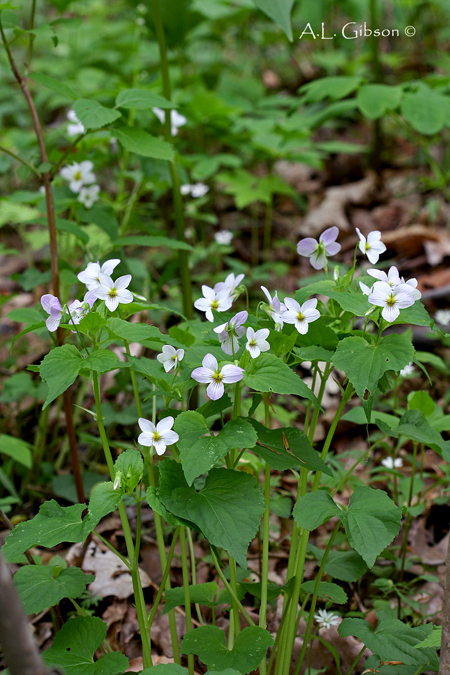
Chasmogamous flowering habit by Andrew Gibson, "Buckeye Botanist" website
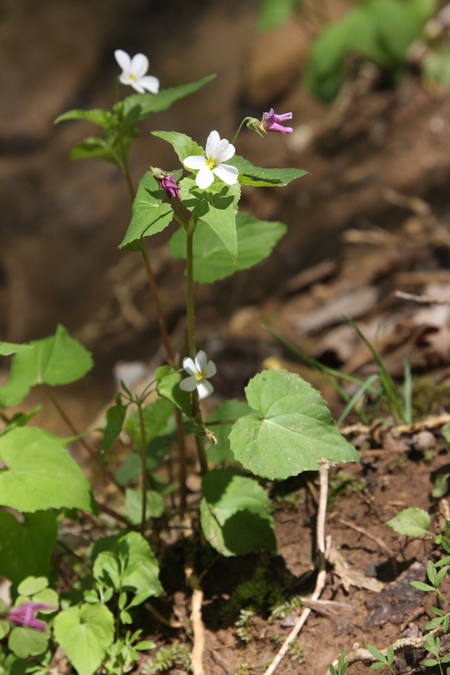
Leaves during chasmogamous flower by Bruce Sorrie
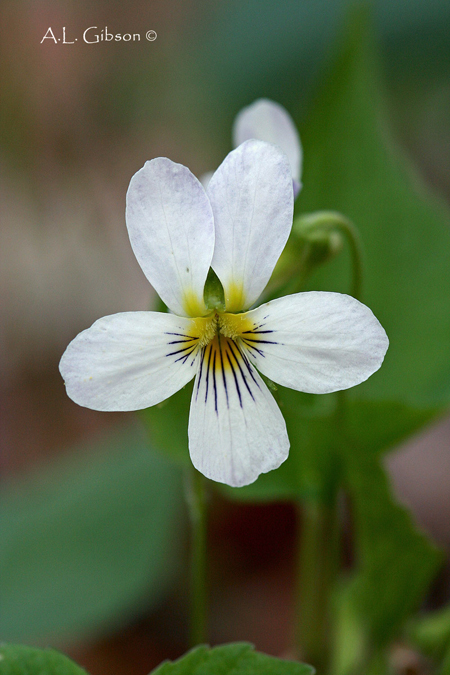
Chasmogamous flower front view by Andrew Gibson, "Buckeye Botanist" website
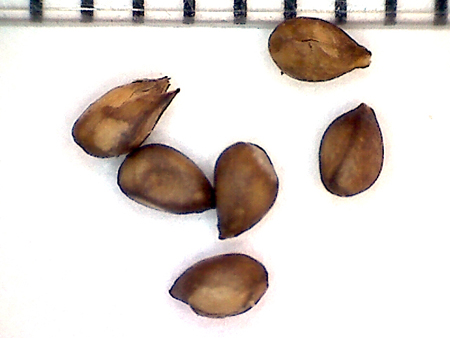
Seeds from herbarium specimen: OH, 17 Jun 1964, E. M. Herrick s.n. (OS75045)
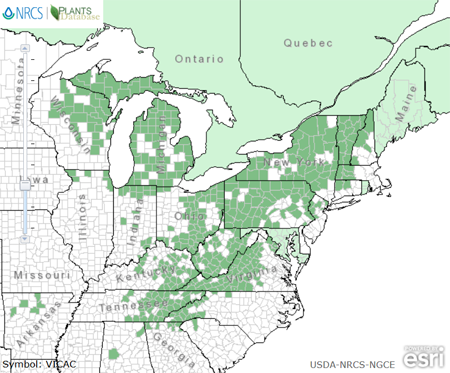
Map by USDA Plants Database (confirmed eastern North American range only)